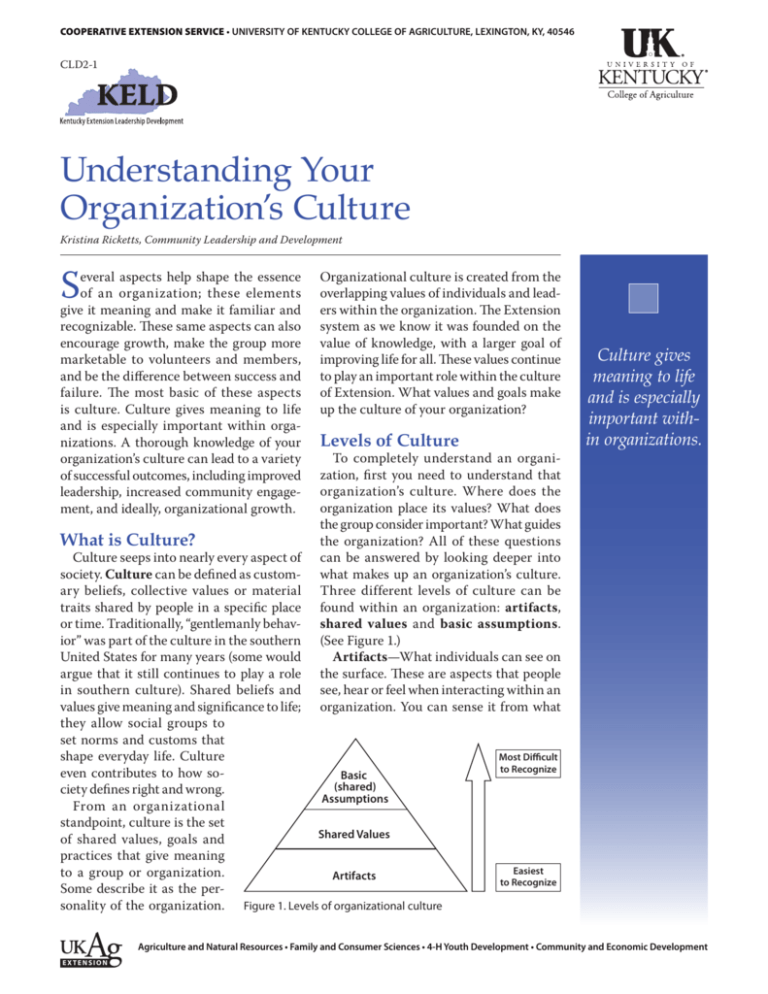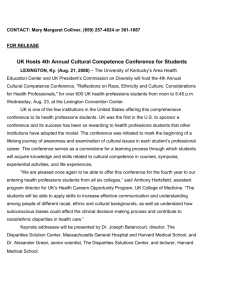CLD2-1: Understanding Your Organization's Culture
advertisement

COOPERATIVE EXTENSION SERVICE • UNIVERSITY OF KENTUCKY COLLEGE OF AGRICULTURE, LEXINGTON, KY, 40546 CLD2-1 Understanding Your Organization’s Culture Kristina Ricketts, Community Leadership and Development S everal aspects help shape the essence of an organization; these elements give it meaning and make it familiar and recognizable. These same aspects can also encourage growth, make the group more marketable to volunteers and members, and be the difference between success and failure. The most basic of these aspects is culture. Culture gives meaning to life and is especially important within organizations. A thorough knowledge of your organization’s culture can lead to a variety of successful outcomes, including improved leadership, increased community engagement, and ideally, organizational growth. What is Culture? Organizational culture is created from the overlapping values of individuals and leaders within the organization. The Extension system as we know it was founded on the value of knowledge, with a larger goal of improving life for all. These values continue to play an important role within the culture of Extension. What values and goals make up the culture of your organization? Levels of Culture To completely understand an organization, first you need to understand that organization’s culture. Where does the organization place its values? What does the group consider important? What guides the organization? All of these questions can be answered by looking deeper into what makes up an organization’s culture. Three different levels of culture can be found within an organization: artifacts, shared values and basic assumptions. (See Figure 1.) Artifacts—What individuals can see on the surface. These are aspects that people see, hear or feel when interacting within an organization. You can sense it from what Culture seeps into nearly every aspect of society. Culture can be defined as customary beliefs, collective values or material traits shared by people in a specific place or time. Traditionally, “gentlemanly behavior” was part of the culture in the southern United States for many years (some would argue that it still continues to play a role in southern culture). Shared beliefs and values give meaning and significance to life; they allow social groups to set norms and customs that shape everyday life. Culture even contributes to how soBasic (shared) ciety defines right and wrong. Assumptions From an organizational standpoint, culture is the set Shared Values of shared values, goals and practices that give meaning to a group or organization. Artifacts Some describe it as the personality of the organization. Figure 1. Levels of organizational culture Culture gives meaning to life and is especially important within organizations. Most Difficult to Recognize Easiest to Recognize Agriculture and Natural Resources • Family and Consumer Sciences • 4-H Youth Development • Community and Economic Development EXTENSION employees’ wear, the way the furniture is arranged, how employees or volunteers behave towards one another, etc. Generally, artifacts of an organization are easy to observe, but it may be difficult for an outsider to decipher what they truly mean. Shared Values—The significant values, morals or beliefs claimed to be especially important by leaders within the organization. All deeper levels of organizational culture begin as a shared value and eventually become shared basic assumptions (over time, after repetition). For example, values such as trust, honesty and integrity play a strong role within the moral structure of many organizations. Basic Assumptions—How situations or problems within the organization are treated after repetition; they evolve as the situation is repeated over and over again. Rules, policies, and procedures found within an organization are based on shared basic assumptions that have developed within the organizational culture. A good example of shared assumptions within any group is the constitution or bylaws by which the group is governed. Each of these cultural levels can be found within most groups or organizations. They are described as “levels” because they build on each other—each level is a little deeper than the previous level. Often, it takes time for a brand new group to develop its shared values and assumptions. Still, it is important that leaders take the time to establish strong organizational values; these values drive the organization’s culture and affect everything from member recruitment and retention, to group productivity, to organizational success. The Effects of a Positive or Toxic Culture Organizational culture can be positive or negative, depending upon what is being demonstrated and communicated within the organization. Positive organizational culture is the opposite of toxic culture—it incorporates member or employee wellbeing as well as organizational success 2 into the overall picture. This combination results in successful outcomes for everyone involved and can be recognized several ways: • Do members or volunteers enjoy attending meetings? • Does the group or organization get things done? (Is the group active?) • Are the primary values of the organization recognizable within the organization’s vision or mission? • Are individuals seeking membership or participation within your group? Leaders who are clear about their organization’s purpose and who can define what good volunteers or organizational members look like are developing their organization’s culture in the right direction. Good examples of this are organizations such as Southwest Airlines, Kroger and Amazon. Due to aspects such as their concern for employee satisfaction, service to local communities and positive organizational values, these organizations have positive organizational cultures. But what happens when an organization’s culture isn’t functional, purposeful or successful? Unfortunately, some groups experience a toxic culture—a culture that is lethal to the well-being of its members as well as the overall success of the organization. Signs of a toxic culture include: • Rampant gossip and/or rumors • Us vs. them mentality • Retaining poor talent • Double standards for leadership (i.e. accountability, rewards, etc.) • Inconsistency When a leader encounters a culture like this (or recognizes this is what their culture has become), it is important that organizational change is addressed before the organization and its members are permanently affected. Enron is a prime example where dishonesty permanently affected the organization’s overall culture and ultimately led to bankruptcy for the company (and jail for many executives involved). Even if a toxic culture isn’t part of your organization, a leader should consider change when what is happening within Organizational culture can be positive or negative, depending upon what is being demonstrated and communicated within the organization. the organization is different than what is desired. Consider these questions: • Is your organization on track to achieve its vision? • Are your organization’s projects delivering the desired outcomes? Are they finished on time and on budget? • Is your organization maintaining high levels of productivity and morale? • Are your people energized, committed and passionate? If you answered “No” to any of the questions listed above, it may be time to consider introducing change into your organization. A mistake many leaders make when considering change is looking at organizational structures (i.e. changing rules, policies, leaders, etc.) and not considering that culture may be the problem. Changing organizational structures, rules, policies and procedures as well as replacing leaders should happen once an organization’s culture is thoroughly examined. If the artifacts, shared values and basic assumptions of a group aren’t contributing to its success, it is time for the leader to step back and initiate cultural changes. The bottom line is this: Without changing the underlying organizational culture, any structural changes made won’t help an organization reach success in the end. Conclusion Organizational culture is an important aspect that is often overlooked or misunderstood by leaders. Understanding what culture is and what makes up different levels within an organization’s culture as well as recognizing the difference between positive and toxic cultures are all keys to a healthy organization. Ideally, having a strong organizational culture means stability for the organization; it gives the organization permanency and encourages it to look into the future. References Edmonds, C. (2010). Creating a High Performance, Values-Aligned Culture. Ken Blanchard Companies. Powell. W. (2011). Top 5 Signs of a Toxic Culture. The Leadership Advisor. Retrieved from: http://www.theleadershipadvisor. com/2011/05/12/top-5-signs-of-a-toxicculture/. Schein, E. (n.d.) Organizational Culture & Leadership. Retrieved from: http://www. tnellen.com/ted/tc/schein.html. Educational programs of Kentucky Cooperative Extension serve all people regardless of race, color, age, sex, religion, disability, or national origin. Issued in furtherance of Cooperative Extension work, Acts of May 8 and June 30, 1914, in cooperation with the U.S. Department of Agriculture, M. Scott Smith, Director, Land Grant Programs, University of Kentucky College of Agriculture, Lexington, and Kentucky State University, Frankfort. Copyright © 2013 for materials developed by University of Kentucky Cooperative Extension. This publication may be reproduced in portions or its entirety for educational or nonprofit purposes only. Permitted users shall give credit to the author(s) and include this copyright notice. Publications are also available on the World Wide Web at www.ca.uky.edu. Issued 1-2013







